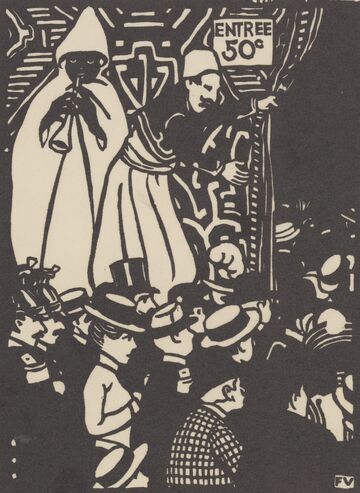The Rue du Caire was a liberal reconstruction of the urban Cairo environment, presented at the Exposition Universelle in 1889 in Paris. It was the first time that Egypt had been depicted there as a street, and not in a pavilion.
The “Rue du Caire” presented in Paris at the Exposition Universelle in 1889 was, for its promotor Baron Alphonse Delort de Gléon (1843-1899), the conclusion of a project begun twenty years before when, as a young mining engineer expatriated to Egypt to take over the business of his wealthy uncle, he discovered the splendours of Islamic art: “this charming, so little-known art, which I have long studied and loved from the very first day”. He then went about giving life back to the Mameluke and Ottoman architecture of Cairo, in its contemporary versions, while putting together a precious collection of Islamic objects, subsequently donated to the Louvre, thus allowing for the establishment of an Islamic section.
In 1871-1872, the collector had had built in the new quarters of Cairo a house “in the Arab style”, designed by the architect Ambroise Baudry (1838-1906). The centre of this dwelling borrowed the layout of the large cruciform rooms of the Mameluke and Ottoman houses, lit by a central roof-light. Both the interior and exterior decors were scattered with ornamental mouldings taken from the historical sites of Cairo, and this procedure was repeated in Paris in 1889. Features designed according to the Mameluke taste rounded off this ornamentation, such as the characteristic mosaics of polychrome marble that decorate the older constructions in Cairo, or woodwork decked with stars. Daylight is filtered through plaster stained-glass windows and mashrabiyas. Turquoise and royal-blue tiles from the Ottoman period were set around the door. The furnishing consisted of antique wooden pieces reconstituted in a modern context. Hangings made of openwork copper lit up the rooms. This was the house of a collector, but also a sponsor: for several years, Delort’s house acted as a “Villa Médicis in Cairo”, where passing painters, most of them from Jean-Léon Gérôme’s studio, could find studios and models. When Great Britain occupied Egypt in 1882, Delort rented out his home and had a more modest version of it built, still inspired by the local architecture, based on the principle of recycling former decors. As for the Parisian town house that he acquired at the same time, he included neo-Islamic rooms in it, one of which was a large lounge with a mashrabiya.
So it was that this street, which was put together in Paris in 1889, came from a mature, and highly experienced approach, in which the effect of authenticity derived from the inclusion of replicas, as well as the reuse of new constructions. “I tried as best I could to invent as least as possible and stick to an interpretation of an absolute sincerity”, claimed Delort in a publication, illustrated by his own photographs, devoted to this production. Covering 150m beside the Palais de l’Industrie, the street was designed as a set of architectural styles that were typical to Cairo. On either side of the street could be found a fountain-school, (sabil-kuttab), constructions with two floors, with the lower one sheltering a public water tank and the second a Quranic school, stores with wooden façades, a café, and even the copy of the minaret, with one floor less, from the funerary mosque of Sultan Qaitbay, which had been finished in 1476. As for the houses of Delort de Gléon in Cairo, antique mashrabiyas, doors and banisters were included in the structures, as well as earthenware. Use was once again made of moulds for the scalloped arches and the monumental entrances to the bazaar. To complete this illusion of an architecture marked by the time, the façades were given a plain-looking roughcast which thus created the desired patina. In all, twenty-five different façades were erected.
However, it was less the decor and layout of the street than its animation that made of it a real success, and one of the Exposition’s linchpins. In order to make it seem truly credible, Delort de Gléon had brought over from Cairo fifty donkey-drivers with their donkeys, giving rides to the visitors, be they adults or children. A café served Turkish coffee; belly dancers performed in the evening. The stalls of the Egyptian merchants recruited by Delort de Gléon were a collectors’ delight. Artists went there in the morning looking for local colour. René Binet’s watercolours give a good idea of the mood. While the ethnographic dimension, thought to be excessively orientalist, of this type of reconstitution would stain its aura in the future, the public at the time quite simply enjoyed it. As was the custom, at the end of the Exposition the decors of the Rue du Caire were taken down and sold. Delort kept a series of woodwork and mashrabiyas, which he used in the resort at Arromanches in a holiday chalet, locally called the “Villa Arabe”. This seems to have been the last use made of these pieces, whose trace then became lost.
Image Caption : Rue du Caire - "Exposition Universelle". V. Estampe de Félix Vallotton, 1901


